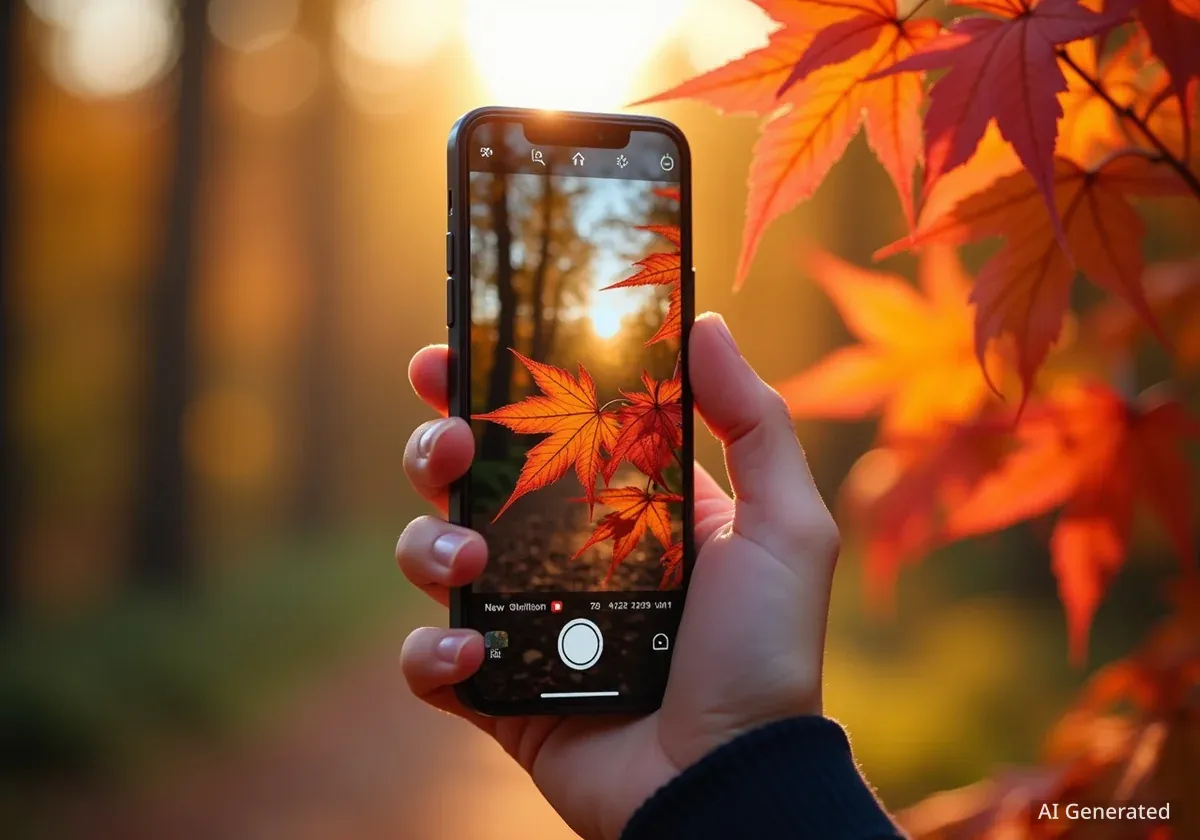As autumn approaches, many people head to the mountains to see the changing leaves. Capturing the beauty of fall foliage can be simple, even with just a smartphone. A University of Denver Enrichment instructor offers practical advice for taking stunning photos directly from your mobile device, emphasizing that modern phones can achieve professional-level results with the right techniques.
Key Takeaways
- Modern smartphones offer advanced photography capabilities.
- Explore different angles and lenses for diverse shots.
- Use grid lines and levels for better composition.
- Lock focus and adjust exposure for optimal lighting.
- Shoot during 'The Golden Hour' for natural light.
- Edit photos subtly to enhance quality without degradation.
Smartphones Rival Professional Cameras
Jeannette Burkle, an instructor who teaches cell phone photography at DU Enrichment, highlights the significant progress in smartphone camera technology. She believes that understanding basic photography principles, along with the strengths and limitations of a smartphone, allows users to capture high-quality images.
"If you know the basics of photography, and you know the strengths and the limitations of your smartphone, I think you can get some very outstanding photographs that rival those taken with professional cameras," Burkle states. "The fact that our smartphones take such great photos now, I think that has opened it up to so many more people to just hop in their car, take a hike and get photographs of the leafs."
This accessibility encourages more individuals to engage in photography, especially during popular events like leaf peeping season.
Did You Know?
Many modern smartphones include multiple lenses, such as ultra-wide and telephoto, which provide greater versatility than older models. These lenses allow photographers to capture different perspectives of the same scene.
Finding the Best Angles and Using Lenses
Burkle's first piece of advice is to actively seek out the best vantage points for your photos. She encourages photographers to move around and experiment with various angles. This active exploration can reveal unique perspectives of the fall colors.
She also suggests utilizing all available lenses on your smartphone. Many phones now feature multiple lenses, including ultra-wide and telephoto options. These lenses can help tell a more complete story of your outdoor adventure.
- Ultra-wide shots: Capture expansive landscapes.
- Telephoto shots: Bring distant subjects closer, highlighting specific details.
Using a mix of these lenses adds depth and variety to your photo collection.
Activating Grid Lines and Levels for Composition
A fundamental step in improving photo composition is enabling grid lines and levels in your camera app. This feature is available on both iPhone and Android devices.
For iPhones:
- Go to Settings.
- Select Camera.
- Under Composition, toggle on Grid and Level.
For Android phones:
- Open Camera Settings.
- Navigate to General.
- Enable the Composition Guide.
Burkle explains that grid lines help users understand the rule of thirds, a compositional guideline that divides an image into nine equal parts. Placing subjects along these lines or at their intersections often creates more balanced and engaging photographs. For instance, aligning the horizon with one of the horizontal grid lines can significantly improve landscape shots.
The Rule of Thirds
The rule of thirds is a basic principle in photography that suggests off-centering your subject. By placing key elements along the grid lines or at their intersections, photographers can create more dynamic and visually interesting compositions compared to simply centering the subject.
Mastering Focus and Exposure Settings
Understanding how to lock focus and adjust exposure on your smartphone camera is crucial for clear and well-lit images. These settings allow you to control which part of the scene is sharp and how bright or dark the photo appears.
On an iPhone:
- Touch and hold on the screen to lock the focus on your chosen subject.
- Drag up or down on the screen to adjust the exposure.
On an Android device:
- Touch and hold on the screen to lock the focus.
- Drag left or right on the screen to adjust the exposure.
This ability to lock focus and exposure means you can take multiple pictures at the same settings, ensuring consistency across a series of shots. This is particularly useful when photographing vibrant but tricky subjects like autumn leaves, where lighting conditions can change rapidly.
Photographing During The Golden Hour
One of the most impactful tips Burkle offers is to take photos during The Golden Hour. This period occurs twice a day: just after sunrise and right before sunset. During these times, the sun is low in the sky, producing a soft, warm light that enhances colors and reduces harsh shadows.
"That means either right after sunrise or right before sunset," Burkle explains. "It is truly golden. There’s more of a balance between the lights and shadows. It’s just a gorgeous time."
The natural warm tones and balanced lighting during The Golden Hour can make autumn leaves appear even more vibrant and rich, resulting in stunning photographs without heavy editing.
Purposeful Photography and Mindful Shooting
Burkle emphasizes the importance of shooting with a purpose. Instead of simply pointing and clicking, she advises photographers to think about the story they want to tell with each image. This mindful approach involves identifying your subject and understanding the narrative of the scene.
Before pressing the shutter, ask yourself:
- What is the main subject of this photo?
- What story am I trying to convey about this scene?
- What elements should I include or exclude?
This deliberate process helps create more meaningful and impactful photographs, rather than just random snapshots. It encourages a deeper connection with the subject matter.
Subtle Photo Editing for Best Results
The final step in capturing the perfect leaf peeping photo is editing. Burkle suggests editing your photos, but with a strong emphasis on moderation. Over-editing can degrade the image quality, especially when increasing saturation or sharpening too much.
"I do believe that less is more when it comes to editing," she says. "One of the things I recommend for editing is to zoom in on your photos as you’re editing it. It is very tempting to try to up the saturation or up the sharpening, but if you look at the details, you end up understanding how much you will degrade that file if you do too much."
Small adjustments to brightness, contrast, and color can enhance the natural beauty of the leaves without making the image look artificial. Always zoom in to check the details and avoid pushing adjustments too far. The goal is to refine, not reinvent, the original capture.
By following these expert tips, anyone can take striking autumn foliage photos using only their smartphone, transforming simple snapshots into memorable visual stories.




